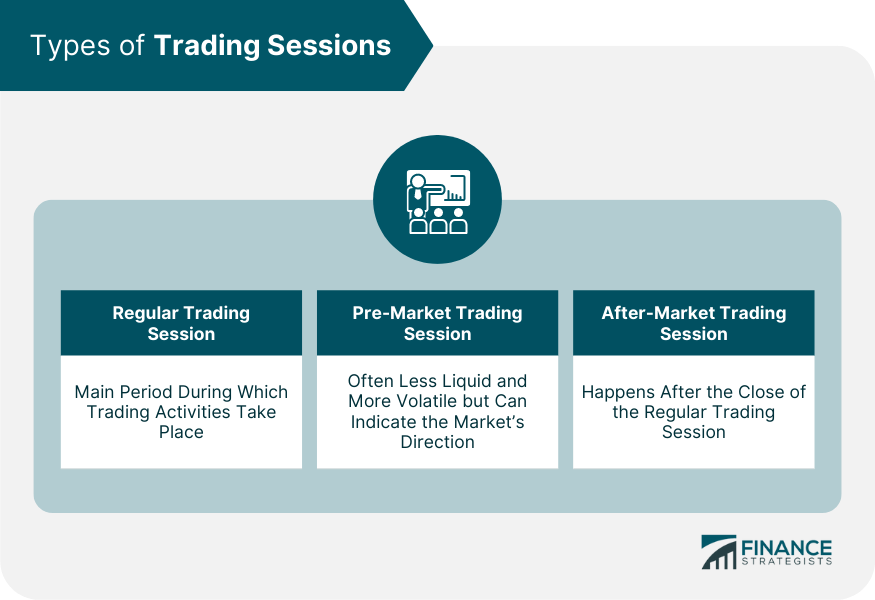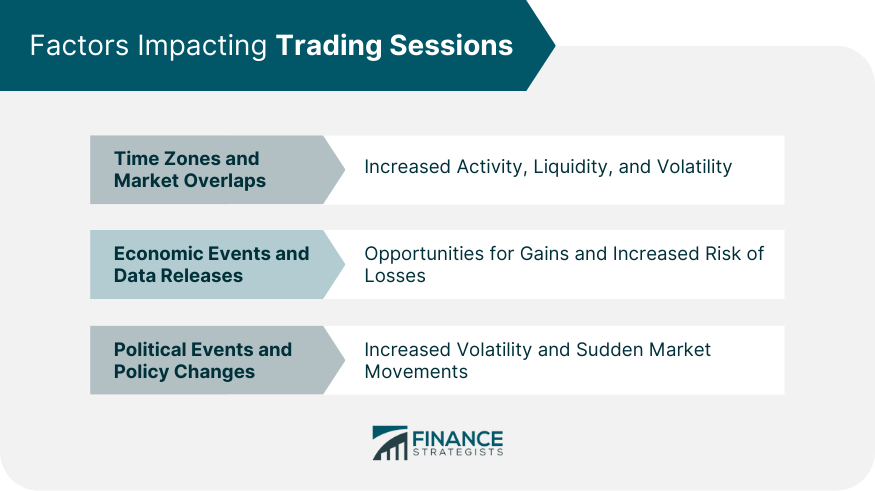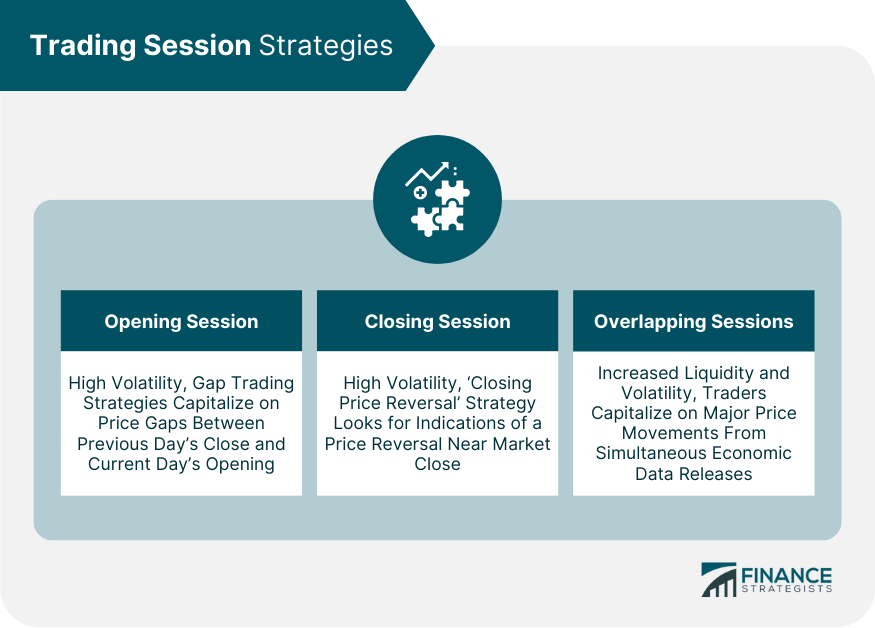A Trading Session refers to the time period during which a stock exchange is open and operational for trading. It's the window within which traders can buy or sell stocks, bonds, commodities, and other financial instruments. Trading sessions are vital for shaping market behavior as they directly influence market dynamics, including volatility and liquidity. In essence, the timing and type of trading sessions, which include regular, pre-market, and after-market sessions, play a critical role in investment decisions, trading strategies, and overall market performance. Moreover, with the advent of globalized markets, trading sessions span various international exchanges, enabling continuous trading activity. Understanding these sessions is vital for traders and investors to navigate the financial markets successfully. The regular trading session, often known as the 'core trading session', is the primary trading period recognized by major exchanges around the world. For example, in the New York Stock Exchange (NYSE) and NASDAQ, the regular trading session runs from 9:30 a.m. to 4:00 p.m. Eastern Time. Pre-market trading typically occurs before the regular trading session begins. Despite being less liquid and having more price volatility, it provides an early indication of the market's direction. It's also a time when major financial news, such as earnings reports or economic indicators, are released. The after-market trading session happens after the close of the regular trading session. Like the pre-market session, it can be a volatile trading period but allows investors to react to news events that occur outside of regular trading hours. As we live in a globalized world, trading in financial markets happens around the clock. When one major market closes, another one opens, creating a continuous cycle of trading activity. The Asian trading session, also known as the Tokyo session, is the first to open and thus gives the initial direction to the markets. This session can be impacted by economic data releases from Australia, New Zealand, and Japan, among others. The European session, often called the London session, overlaps with the latter part of the Asian session and the beginning of the North American session. The London session is known for its high volatility as it encompasses a significant portion of forex transactions. The North American session, centered around New York, is the last to open and overlaps with the late European session. This session often experiences high trading volume and volatility, especially at the opening and closing hours. Market overlaps occur when two major markets are open at the same time. These periods can see increased trading activity, liquidity, and volatility due to the confluence of a greater number of market participants. Economic data, such as employment figures, GDP data, or central bank decisions, can significantly influence market dynamics. These data releases often happen at predetermined times and can result in increased market activity. Political events, such as elections, and policy changes can create uncertainty, leading to increased volatility during certain trading sessions. Traders need to keep a close eye on these events to anticipate possible market movements. The opening session is often characterized by high volatility as the market reacts to overnight news and events. Strategies for trading this session could include gap trading strategies, where traders aim to profit from the price "gaps" that occur between the previous day's close and the current day's opening price. The closing session, like the opening session, can also experience high volatility. One popular strategy for this period is the 'closing price reversal' strategy, where traders look for indications of a price reversal as the market nears its close. Trading during overlapping sessions can provide opportunities due to increased liquidity and volatility. For instance, traders can look to capitalize on major price movements resulting from the simultaneous release of economic data from two different markets. Financial regulatory bodies, like the Securities and Exchange Commission (SEC) in the U.S., define the standard market hours and have rules governing trading outside these hours. Traders must be aware of these regulations to ensure compliance. Regulations for pre-market and after-market sessions can vary and are often different from those for the regular trading session. For example, the SEC has rules about the type of orders that can be placed during these sessions to protect investors from increased risks. Trading session refers to the time period during which a stock exchange is open and operational for trading. It's the window within which traders can buy or sell stocks, bonds, commodities, and other financial instruments. They can be divided into regular, pre-market, and after-market sessions. Global trading sessions span various international exchanges, enabling continuous trading activity. Factors that impact trading sessions include time zones and market overlaps, economic events and data releases, and political events and policy changes. Strategies for trading during different sessions include gap trading, closing price reversal, and trading during overlapping sessions. Regulatory bodies, like the SEC in the U.S., define the standard market hours and have rules governing trading outside these hours. By understanding the different types of trading sessions and the factors that impact them, traders can make informed decisions about when and how to trade.What Is a Trading Session?
Types of Trading Sessions
Regular Trading Session
Pre-market Trading Session
After-Market Trading Session

Global Trading Sessions
Overview of Global Trading Sessions
Asian Trading Session (Tokyo)
European Trading Session (London)
North American Trading Session (New York)
Factors Impacting Trading Sessions
Time Zones and Market Overlaps
Economic Events and Data Releases
Political Events and Policy Changes

Trading Session Strategies
Opening Session
Closing Session
Overlapping Sessions

Regulations and Trading Sessions
Market Hours as Defined by Financial Regulatory Bodies
Regulations Impacting Pre-market and After-Market Sessions
Conclusion
Trading Session FAQs
A trading platform is a software application that serves as the interface for traders during a trading session. It allows traders to place trades, view real-time price data, analyze markets using various tools, and manage their accounts.
Yes, most modern trading platforms allow you to trade during regular, pre-market, and after-market sessions. However, specific rules and risks associated with pre-market and after-market trading sessions apply, so ensure you understand these before trading.
Trading platforms typically provide real-time data feeds and market news from various exchanges around the world. This allows traders to monitor and respond to market changes during Asian, European, and North American trading sessions.
Trading platforms usually offer a range of tools and features such as technical indicators, economic calendars, and algorithmic trading capabilities. These can be used to implement various strategies suitable for different trading sessions.
Electronic trading platforms allow for trading outside traditional market hours, accommodating pre-market and after-market sessions. This feature gives traders the flexibility to respond to market events and news that occur outside regular trading hours.
True Tamplin is a published author, public speaker, CEO of UpDigital, and founder of Finance Strategists.
True is a Certified Educator in Personal Finance (CEPF®), author of The Handy Financial Ratios Guide, a member of the Society for Advancing Business Editing and Writing, contributes to his financial education site, Finance Strategists, and has spoken to various financial communities such as the CFA Institute, as well as university students like his Alma mater, Biola University, where he received a bachelor of science in business and data analytics.
To learn more about True, visit his personal website or view his author profiles on Amazon, Nasdaq and Forbes.











